EOS: Developing metal Additive Manufacturing for a truly digital factory
In July 2018, Metal Additive Manufacturing magazine’s Emily-Jo Hopson attended the company’s exclusive EOS Technology Days for an advance preview of its new metal Additive Manufacturing system, the EOS M 300, and a look at its vision for AM and the technology’s place in the digital factory of the future. Held at the company’s attractive rural headquarters in Krailling, Germany, the event offered attendees insight into areas that are key to EOS’s current development strategy. [First published in Metal AM Vol. 4 No. 3, Autumn 2018 | 10 minute read | View on Issuu | Download PDF]
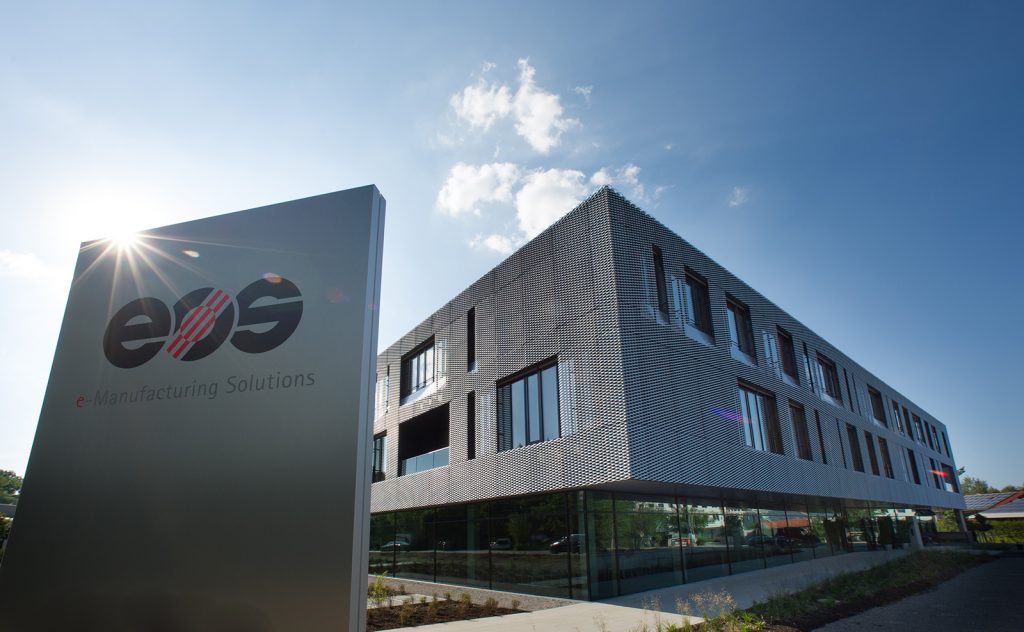
Founded in 1989, EOS has long been recognised as a global technology leader at the forefront of the industrial Additive Manufacturing of both metals and polymers. The company’s portfolio includes a range of Additive Manufacturing systems, materials, global services, applications engineering and consultancy, all designed to give customers crucial competitive advantages in terms of product quality and long-term economic sustainability for the adoption of AM. Fuelled by the belief that Additive Manufacturing has the potential to enhance the industrial value chain, its industrial AM systems are developed with the aim of making it possible for customers to react quickly to changing requirements. Such systems enable applications that weren’t possible before, meet increasing demand for customisable end-products and help customers achieve sustainability goals in markets such as aerospace, automotive, medical, tooling and more.
EOS currently has an installed base of more than 3,000 systems around the world. While it took roughly twenty years for the company to bring its first 1,000 systems into the market, it has installed the last 1,000 of its AM systems over the last three years. These numbers emphasise just how fast the industry and the market are growing; the company now has a network of global sales and service offices in fifteen countries, along with six innovation centres and more than 260 service specialists.
The digital factory
In his welcome address, Thomas Weitlaner, Director of Business Development at EOS, used the example of the pace of automotive adoption to demonstrate how quickly he believes the manufacturing industry must be ready to adapt to the changing landscape of ‘Industry 4.0’. Using a picture of a New York City street in 1900, Weitlaner asked the audience to spot the car: a single automobile travelling between two horse-drawn vehicles. In the next photograph, taken barely more than a decade later in 1913, the opposite had become the case, and a single horse-drawn carriage travelled amid the flow of automotive traffic, the former technology superseded by the latter. If in the early 20th century this process took just thirteen years, Weitlaner suggested, we can expect things to move much quicker in the 21st century.
In a survey taken at EOS’s European Excellence Days, the majority of the company’s customers reported that they expected fully integrated digital factories will be standard by 2025; however, Weitlaner stated that the industry can expect this to happen much sooner, with EOS predicting a ramp-up of digital industrial serial production by 2020, including the implementation of suitable quality control, differentiation, total cost optimisation, automation and technology integration (Fig. 2). “The speed of innovation will get faster and faster,” he stated, “and it will not stop with B2C, it will affect B2B as well. Here at EOS, we are prepared to support you through this.”
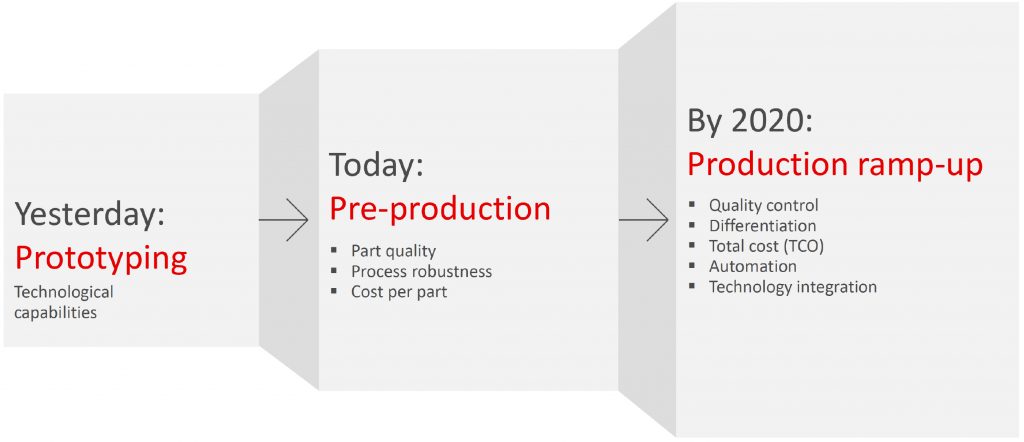
Industry 4.0 has become a widely used buzzword in recent years when referring to the ‘fourth industrial revolution’ which many believe we are living through: a period in which the global manufacturing industry will see the increased adoption of AM and other digital technologies such as robotics, Artificial Intelligence (AI), and an increasing degree of technology convergence – whereby interconnected digital technologies enable new opportunities for both established and new methods of production.
EOS believes that the large-scale digitalisation of industrial production is key not just to the development, but to the future of the manufacturing industry. As product life-cycles shorten, and product variety continues to increase, manufacturing methods based on economies of scale are not in a position to meet these challenges. Economical conventional manufacturing depends on the sale of high volumes of identical products; tool-based manufacturing methods simply are not capable of filling the increased demand for customised products cost-effectively. This is where Additive Manufacturing, as a flexible manufacturing method, comes into its own.
As part of the NextGenAM project launched in May 2017 with industry partners Premium AEROTEC and Daimler, EOS has been accelerating the implementation of metal AM in large-scale serial production and the development of the ‘factory of the future’. The primary objective of the project is to move toward the automation of the entire industrial AM process, focusing on key areas such as the delivery of metal powder and post-processing, as well as the development and qualification of other materials, such as aluminium, to enable new applications. At the time of its launch, the project partners stated that they expected to invest several million euros into the planning and construction of an automated production facility. The first pilot plant is located in Varel, Germany, and currently consists of a number of AM machines and solutions for post-processing and quality assurance.
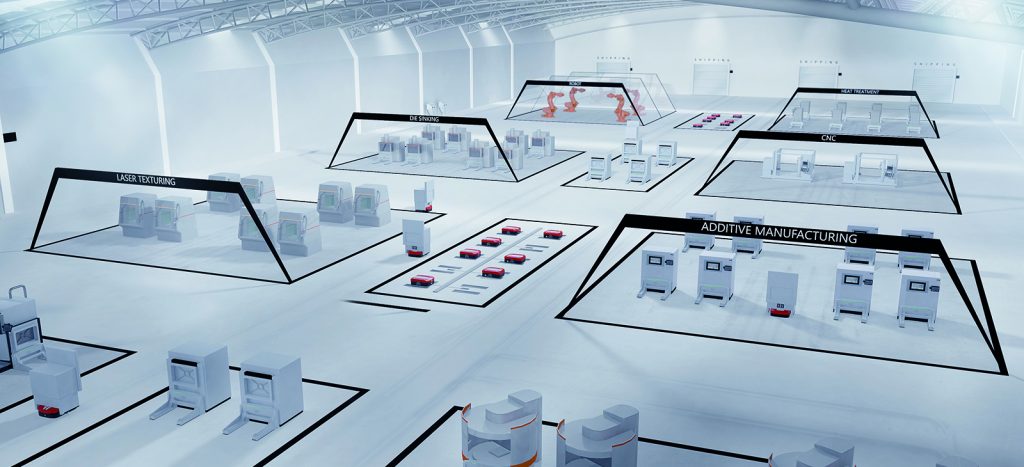
At this pilot plant, the partners have reportedly achieved the full automation of individual steps in the AM workflow, as well as all interactions between additive and conventional process steps, eliminating manual steps entirely. Central to the pilot production chain is an EOS M 400-4 four-laser system, which is being used in combination with the peripheral solutions offered as part of EOS Shared Modules, in which manual or automated peripheral modules and transport logistics will supply several EOS metal AM systems at once. This means that filling and emptying the plant’s EOS M 400-4 with metal powders, the preparation of new builds and the unpacking of built components from the powder bed can be carried out independently of, and parallel to, the actual AM build process – significantly increasing productivity.
Downstream post-processing has also been extensively automated. AM components are transported between individual stations in a fully automated process. Following build completion, a robot removes the build plate with the parts on it from the set-up station and transports it, under protective gas, to a furnace for subsequent heat treatment. The same robot then removes the build plate from the furnace and transports it to a three-dimensional optical measurement system for quality assurance purposes. Finally, the build plate is conveyed to a saw, which separates the parts from the plate.
The EOS Shared Modules system in Varel is one of the first implemented models currently in operation, with further pilot models installed at some undisclosed partners.
The EOS M 300: Designed with industrialisation in mind
The EOS M 300 series was first previewed during the EOS Technology Days and saw its official launch in September 2018 at the International Manufacturing Technology Show (IMTS) in Chicago, Illinois, USA. The new metal Additive Manufacturing machine expands the portfolio of EOS systems and is described as an ‘automation-ready, future-proof platform’ that is configurable, scalable and secure (Fig. 4). It is expected to serve customers in a variety of manufacturing fields, including the aerospace, medical, tooling and automotive industries.
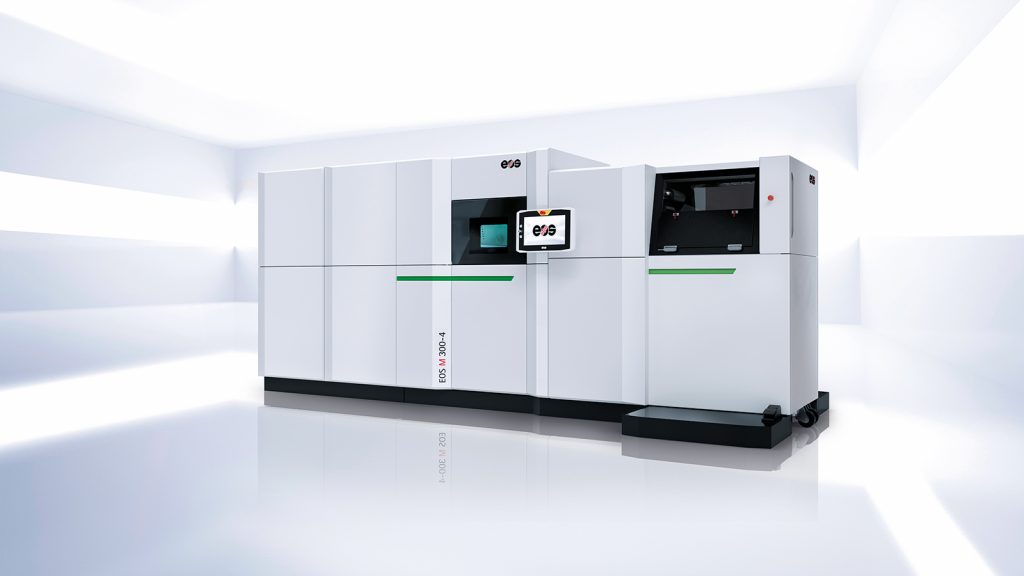
During EOS’s Technology Days, Dr Tim Rüttermann, Director of Product Management at EOS, explained that the EOS M 300 series is “a response to customer demand for something close to the well-established EOS M 290, but scalable for a high-volume production factory setting.” As such, the system comes with a configurable and scalable equipment architecture to enable a degree of user customisation. Employing four lasers, the EOS M 300-4 offers a reported productivity of four to ten times that offered by the EOS M 290. It has a build volume of 300 x 300 x 400 mm, and offers full field overlap with four scanners, meaning that lasers can reach all spots on the build plate and full flexibility is possible with regards to build orientation.
In order to enhance part reliability and quality, Karsten Behrend, EOS Product Management, explained that the new system features a gas flow optimised build chamber. To avoid poor gas flow, the new gas flow design is said to ensure a strong flow of gas both through the top and bottom of the build chamber, thus efficiently clearing smoke and debris generated during processing. Also key to the reliability of the system is the incorporation of a permanent filter system, eliminating the need to open the machine up periodically for filter changes. The new recirculating filter system offers automated cleaning, with residue collected in a bin beneath the build chamber for safe and easy removal.
As EOS turns its focus to series production and the development of solutions for the Industry 4.0, key areas of further development across its product range are increased productivity; reliable and repeatable part quality; production flexibility and automation; and efficient process control. As such, the new system has also been designed for compatibility with EOS Shared Modules.
Software for the digital industrialisation of AM
In addition to its range of AM machines and service offerings, EOS provides four full suites of software developed to support its systems’ users from initial CAD integration all the way through to industrial-grade machine connectivity: EOSPRINT, for job and process management, EOSYSTEM, for system and periphery control, EOSCONNECT, for industrial connectivity, and EOSTATE, for process monitoring and quality assurance.
Speaking during the EOS Technology Days, Martin Steuer, Head of Product Management Software & Services, and Heiko Degen, Product Manager Software, introduced EOS’s software offerings, and looked in-depth at EOSTATE and EOSCONNECT. Highlighted during this presentation was the company’s belief in the importance of a reliable software architecture for quality control, process monitoring and connectivity as a key enabler for the ramp up of digital and additive production at an industrial scale, especially in safety-critical, highly-regulated industries.
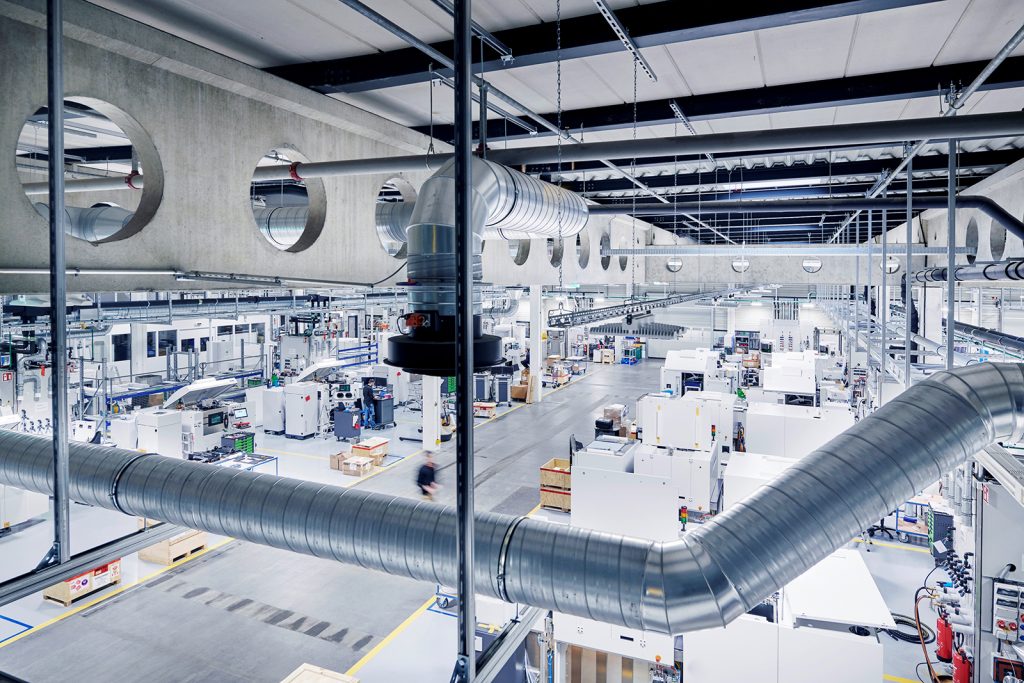
“With the technology constantly maturing, manufacturers realise the broad possibilities AM can enable – from new product design to a disruption of their supply chain. As a consequence, AM is entering production. EOS understands its customer requirements and is constantly adjusting its technology to existing production environments,” stated Steuer.
EOSTATE makes it possible to monitor and correct errors in the powder bed during Additive Manufacturing, and to monitor the process and automatically analyse signals from the system. It can also offer insights to assist in improving process parameters and ensure repeatable and superior part quality, by collecting data and building feedback loops from quality assurance to production. It is itself composed of four different monitoring tools: System, PowderBed, MeltPool and Exposure OT (optical tomography). Especially key to improved industrial-scale AM is Exposure OT, which provides real-time, camera-ba sed monitoring of the build process, fully mapping each part layer-by-layer, regardless of its geometry or size. Developed in close collaboration with MTU Aero Engines, it aims to enable companies to significantly reduce costs for non-destructive examination in computer tomography after the build process, making it possible for potentially defective parts to be rejected at an earlier stage.
The new EOSCONNECT solution is designed to reduce the cost of AM integration by increasing workflow efficiency. This scalable software enables customers to remotely access reports on the condition of their installed EOS AM machines, automatically generates quality reports, collects data and performs analytics across a number of machines to identify production bottlenecks, and offers industry standard connectivity for access to live and historic process data to fulfil regulatory requirements for strictly-controlled industries such as aerospace. With the new releases of EOSPRINT and EOSCONNECT, print jobs (with their necessary CAM files and meta data) can be automatically passed to available and suitable systems. Job performance and quality-relevant data can be queried and aggregated from the systems, resulting in a simple digital workflow from order to part.
Conclusion
Within conventional manufacturing, the gains offered by a digitalised production workflow are already evident. Following the digitalisation of their operations, conventional manufacturers – according to surveys from Siemens and SEW Eurodrive- reported 75% gains in automation and a 25% increase in output and productivity. They also reported a 20% reduction in factory investment and a 50% reduction in inventory, with total savings amounting to €0.5 million (year/line). Moreover, the overall reported quality rate of products manufactured using a digitalised workflow was 99.9988%.
Now, EOS is exploring how factory digitalisation can enable AM to compete with conventional manufacturing by increasing the speed of production for high volumes. It is enabling the technology to be integrated into the factory in the same way as conventional manufacturing technologies, rather than being seen as a separate, stand-alone process. Key to the ability of AM to complement conventional manufacturing will be a reduction in cost-per-part at high volumes; a further maturing of AM technology to enable the repeatable and reliable production of parts to customer quality requirements; and the development of tools to deliver the kind of traceability necessary for part qualification for strictly-controlled industries such as aerospace and automotive.
While EOS’s Additive Manufacturing systems are central to its continued development of an economically viable and effective manufacturing framework for the future, the considerable research and development undertaken by the company into its peripheral technology and software should not be overlooked. As Tim Rutterman explains, “Our mission is to make EOS not just the most attractive platform for metal Additive Manufacturing, but the most attractive ecosystem in which to develop and industrialise applications, materials and processes.”
Contact
EOS GmbH
Electro Optical Systems
Robert-Stirling-Ring 1
82152 Krailling/Munich
Germany
Tel: +49 89 893 36 0
Fax +49 89 893 36 285
[email protected]
www.eos.info







